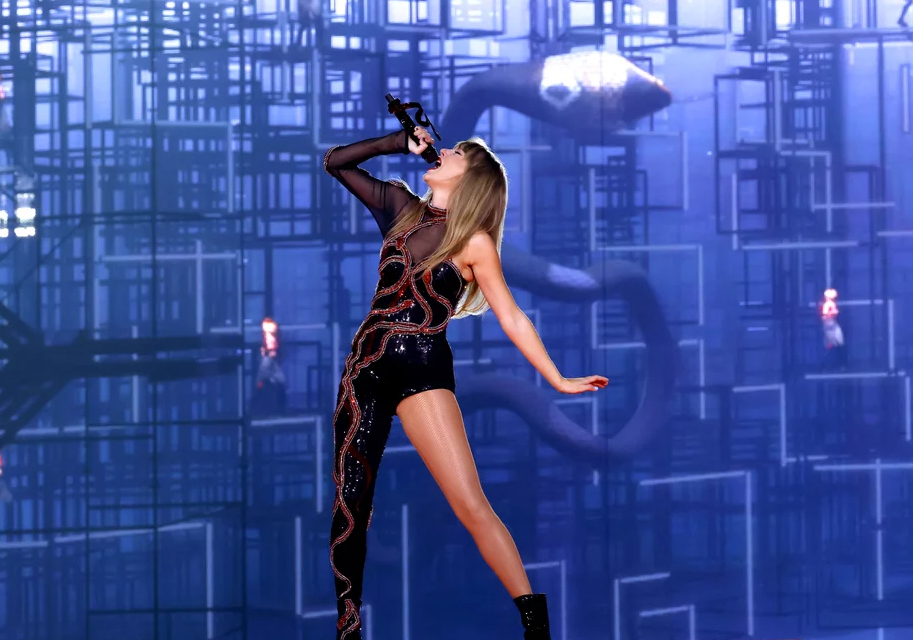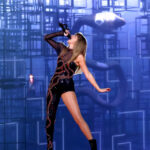
The nineteenth century pianist Franz Liszt inspired an abject frenzy in his fans so intense that people of the time had to make up a special term for it. When reflecting on (and coining) “Lisztomania,” the German poet Heinrich Heine wondered why people were going so wild for Liszt. After discussing some outlandish suggestions, he mused, “Perhaps the solution […] floats on a very prosaic surface. It seems to me at times that all this sorcery may be explained by the fact that no one on earth knows so well how to organize his successes, or rather their mise en scene, as our Franz Liszt.”
Truer words could not have been spoken about the current age of Swiftomania. No one on Earth knows so well how to organize their mise en scene—public image, social media, interviews, music, fashion, concerts—as our Taylor Swift.
Swift is the most Liszt-like celebrity of our time. People have spent exorbitant amounts of money to see her perform in her Eras tour (with some ticket resale prices nearing five digits), purchase special attire to wear to those concerts, plan their bathroom trips (or not) according to setlists. Some faint upon seeing her; others suffer from post-concert amnesia triggered by their heightened emotional state. She caused seismic activity equivalent to an earthquake in Seattle. Her Eras tour generated an estimated $5 billion for the world economy.
She has achieved this by forging an incredible relationship with her fans, the Swifties. She communicates with them via social media, as most celebrities do, but she also communicates with them through her music. Her artistic output is meant to be enjoyed by anyone, but it has also become rich soil where she plants secret messages to her fans.
She calls these secret messages her Easter eggs, hidden messages that fans can unravel to discover different bits of information or hints at what’s to come. She has discussed how much she enjoys leaving these “cryptic clues” for fans, even offering the following definition in an interview with Entertainment Weekly: “When you’re watching a movie or a music video and you notice something in the background, and that something leads to sort of behind-the-scenes information, that’s an Easter egg.” In the same interview, she went on to say, “I love to communicate via Easter eggs. I think the best messages are cryptic ones.”
In doing this, Swift has taught fans all too well to scrutinize her work to the tiniest detail. Fans fixate on songs, music videos, and other elements of her mise en scene, combing them over till they feel they’ve explored every shred of meaning that might be hidden within. Sometimes they’re wrong, of course (despite their protests, there are indeed coincidences). But they also uncover a lot. Although she’s just trying to talk to them, she ends up teaching them skills that educators are constantly trying to cultivate in their students. It’s just that she is dramatically more successful than we are.
The History of Swift’s Easter Eggs
the earliest eaSter eggs appeared in her self-titled debut album. in the liner notes, song lyrics are printed in loWercase wIth a Few uppercase letters scattered seemingly randomly throughouT. when isolated and written out in sequence, the capitalized letters for each sOng spell out a secret Message. swift explAined these easter eggs, stating, “i waNted to do something that incentivized fans to read the lyrics because my lyrics are what I’m most proud of, out of everything thAt i do.”
She did this for several albums while also expanding her Easter egg repertoire. She now drops hints in the music itself (for example, naming characters after real life people, as in “Dear John” or “Betty”), and in the staging for photos, music videos, and performances. Her Easter eggs don’t stop with her work. She has also come to encode secret messages in her fashion or other styling choices, public statements and interviews, and her social media posts.
These Easter eggs fall into a few broad categories. The first and probably most talked-about Easter eggs are foreshadowers. These are hints that foreshadow what’s coming next: release dates for albums and music videos, which re-recorded album will be released next, track lists, song titles, and so on.
Other Easter eggs are contextualizers. They add background information, giving fans additional interpretive resources. Many of the capitalized liner note messages are contextualizers. Red’s “22,” which is about the fun and confusing experience of being twenty-two years old, contains the hidden message: ASHLEY DIANNA CLAIRE SELENA, which is typically read as a reference to her then-close friends Ashley Avignone, Dianna Agron, Claire Kislinger, and Selena Gomez. Contextualizers are important because they have the power to affect our interpretation, as we might focus much more on the theme of friendship in “22” after learning of this, or specifically the theme of friendship among young women. (This is starting to sound like literary interpretation, isn’t it?)
Some Easter eggs are symbols. In one interview, she mentions how palm trees symbolize “rebirth, new beginnings, positive energy,” as in a much-discussed Instagram post. But there are symbols more specific to her, too. In the same interview, she talks about her common symbolic use of the snake, saying that it is “a mascot for feeling misunderstood, or being somebody that is not going to strike unless they’re stepped on.” And many see the snake as a reference to an infamous Tweet where Kim Kardashian is alleged to have called her a snake—which, if true, would make it both a contextualizer and a symbol.
Many of the Easter eggs are just little winks. They’re totally uninformative. They’re more like a secret handshake or an inside joke than anything else. As she says, if a cat appears in her music videos or other public imagery, it’s “just ‘cause I love cats.” To catch these winks, fans already need to know the information encoded in them. During her Eras tour, Swift wore a manicure of ten different colors, one on each finger. The colors of this manicure correspond, in order, to her ten albums, i.e., her eras. But to notice this winking Easter egg, you already need to have the relevant background knowledge: that there are ten albums so far, their historical release order, and that each album has a corresponding color (red for Red, of course, but purple for Speak Now, black for Reputation, and so on). These are the Easter eggs that, well, IYKYK.
Why Swifties Get an A+
Now, Taylor Swift isn’t the only person to use Easter eggs. There is a long, rich history of artists sending encoded messages to their audiences. Don McLean’s 1971 hit “American Pie” has innumerable little Easter eggs. Marvel and Star Wars movies make insider nods to their own histories and foreshadow their future release plans. And Queen Elizabeth was famous for using her fashion choices to express hidden messages.
In scholarly circles, there are much more influential examples. Renaissance painting contains frequent references to ancient Greek and Roman mythology. Symbolism is everywhere in literature and art. There’s even a nineteenth-century art movement named after its use of symbolism. James Joyce is infamous for his countless abstruse allusions, as an entire book of annotations can help you unravel. In fact, literally all allusions are kinds of Easter eggs. They too are contextualizers, symbols, and winks. And foreshadowing is itself a literary term for “Easter eggs” in a text that hint at what’s to come in that text.
High school teachers and college professors spend endless time and energy trying to get students to understand these concepts. They inspire and proselytize and plead so that students will learn to analyze Joyce or Renaissance art the way that Swifties already dissect Swift’s songs, social media, and music videos. Compare this analysis of a Renaissance basin from the Getty Museum to a prominent fan analysis of Easter eggs in Swift’s video of “All Too Well: The Short Film.” Considered back-to-back, they’re clearly doing the same thing. Swift has, in effect, taught an entire generation of fans to engage in art criticism at a level that educators would be thrilled to see. Those fan Easter egg videos definitely get an A+.
Swift has said that “Easter eggs are a way to really sort of expand the experience of seeing something or hearing music.” Her re-recordings are another way to achieve this goal. Some aspects of the re-recordings resemble contextualizers by adding additional interpretive information: re-titlings, changed lyrics (and deliberately un-changed lyrics), and accompanying new music videos and liner notes. They resemble symbols, too. After all, appending “(Taylor’s Version)” to every single re-recorded track is in its own way a symbol of protest. They resemble winking Easter eggs in that the faint sonic differences from the originals are accessible only if one is very familiar with the originals. Their associated media also include foreshadowing Easter eggs, where she’ll hint at which re-recording might be coming next. The point is this: the re-recordings, and in particular these aspects of the re-recordings, are like Easter eggs. They too can “expand the experience” of engaging with Taylor’s Versions.
Easter eggs expand the experience of Swift’s mise en scene in just the same way that allusions and symbolism expand the experience of watching a movie, reading a novel, or looking at art. Some people think that it’s just pop music; it ain’t that deep. But Swift is a practiced expert in subtle messaging. She’s organized her creative output and public presentation very carefully. Maybe it’s reincarnation, or maybe it’s karma, but she’s a Joyce-meets-Liszt for the twenty-first century. Haters gonna hate, but she’s just gonna keep at it. And I only hope that some of those close-reading Swifties use their skills to become art historians or English professors someday.
Alex King is Associate Professor of Philosophy at Simon Fraser University and the editor-in-chief of Aesthetics for Birds.


